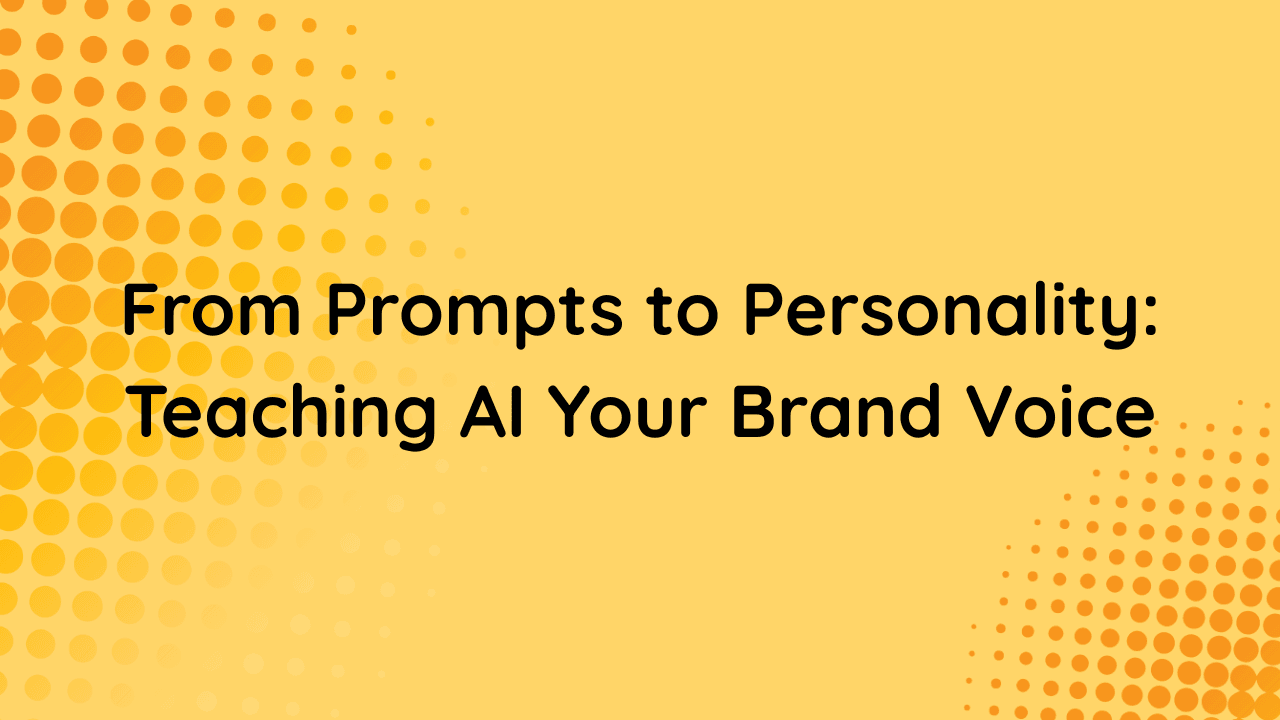From Prompts to Personality: Teaching AI Your Brand Voice

Artificial Intelligence has become a creative partner for brands, helping write blogs, design visuals, and even manage customer communication. But as powerful as AI is, it often lacks one crucial element — your brand’s personality.
When every business is using the same AI tools, what separates your content from everyone else’s is how you teach AI to think, speak, and create like your brand. And that’s exactly where the art of prompting for brand voice comes in.
Why Brand Voice Still Matters in the Age of AI
Your brand voice is more than just tone or word choice — it’s your brand’s identity expressed through language. It’s the difference between “We sell pet care products” and “We help your furry best friend live their happiest, healthiest life.”
AI can generate thousands of words in seconds, but if it doesn’t sound like you, your audience will notice the disconnect. In 2025, where AI content floods every feed, maintaining a consistent and authentic brand voice is what builds trust, loyalty, and recognition.
That’s why teaching AI your brand’s voice isn’t just a creative choice — it’s a strategic one.
The Secret Lies in the Prompt
Every AI output begins with a prompt — your instruction to the model about what you want it to do. But prompts aren’t just commands; they’re the foundation of brand communication in AI.
A weak prompt might say:
“Write a social media caption for a skincare product.”
A strong, branded prompt might say:
“Write a friendly and confident Instagram caption for a cruelty-free skincare brand that uses natural ingredients. Keep the tone empowering, light, and trustworthy.”
That small difference teaches the AI your brand’s attitude, energy, and emotional intent. Over time, these patterns build a personality layer around your AI workflow — a system that knows not just what to write, but how you would write it.
Building Your Brand Voice Prompt Framework
The first step is to define your brand voice clearly — adjectives, examples, and core messages. Think of it as giving your AI a brand style guide. Here’s how you can structure it through prompting:
- Start with a persona statement:
“You are the voice of [Brand Name], a modern, energetic brand that values transparency, creativity, and humor.” - Set tone parameters:
“Always use short, engaging sentences. Speak in a friendly, relatable tone. Avoid jargon. Include emojis only when appropriate.” - Add content goals:
“Focus on creating captions that feel authentic and inspire customer interaction. Highlight benefits, not features.”
By feeding these consistent instructions into your prompts, AI tools start to mirror your brand’s natural communication style.
The Role of Context and Memory
Modern AI models, like GPT-5 or Gemini, are becoming better at remembering context within a conversation or session. This means you can build persistent brand identity into your AI workflows.
Instead of prompting from scratch every time, you can maintain a “brand personality file” — a prewritten description of your tone, audience, and values — that you feed into your prompts before every task.
Over time, your AI learns your rhythm, phrasing, and emotional tone, allowing for smoother, more consistent output across blogs, ads, product pages, and social media.
Examples of Teaching AI Brand Personality
Let’s say your brand is youthful, bold, and playful. Your AI prompts might look like this:
“Write a witty and confident product caption for a new T-shirt launch. Use Gen Z slang naturally and keep the tone bold but approachable.”
If your brand is professional and trustworthy, it might sound like:
“Create a formal product description emphasizing quality, reliability, and expertise. Use calm, professional language with a reassuring tone.”
The more specific your instructions, the stronger the alignment. Think of it like onboarding an employee — the clearer your brand manual, the better the performance.
Scaling Consistency Across Platforms
Once your brand voice is set through prompts, you can replicate it across your entire content ecosystem. From Shopify product descriptions to Instagram posts, from blogs to newsletters, your AI becomes your brand’s creative assistant — always speaking the same language.
This consistency builds brand recognition and customer trust. People begin to recognize your “voice” even before they see your logo — and that’s the magic of mastering AI-driven personality.
The Future: Personalized AI Brand Identities
In the near future, brands will have custom AI personas — digital writers, designers, and marketers that fully embody their tone and aesthetic. These AIs will know your audience, campaigns, and products, making them true creative partners rather than tools.
Training your AI now, through precise and personality-rich prompting, is how you lay that foundation. The brands that start shaping their AI’s “voice” today will stand out tomorrow when everyone else sounds automated.
Final Thoughts
AI can generate content, but you give it soul. Prompting isn’t just a command — it’s a conversation. The more clearly you express your brand’s values, tone, and rhythm, the more human your AI content becomes.
From prompts to personality, the future of branding is about teaching AI how to sound like you — so every word, post, and message feels authentically yours.